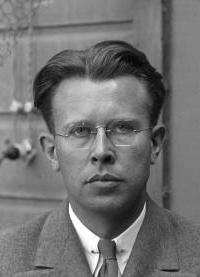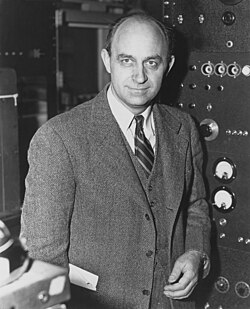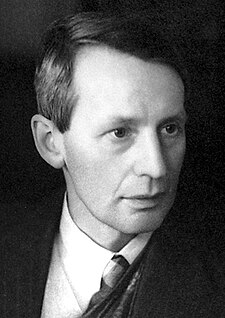Central for Research and Development for Winning
Nobel Prize in Physics at Indonesia
Nobel Fisika Indonesia
Ernest Lawrence
Ernest Orlando Lawrence
The Nobel Prize in Physics 1939 was awarded to Ernest Lawrence "for the invention and development of the cyclotron and for results obtained with it, especially with regard to artificial radioactive elements".
Photos: Copyright © The Nobel Foundation
| Ernest Lawrence | |
|---|---|
 Ernest O. Lawrence | |
| Born | August 8, 1901 Canton, South Dakota |
| Died | August 27, 1958 (aged 57) Palo Alto, California |
| Residence | United States |
| Nationality | American |
| Fields | Physics |
| Institutions | University of California, Berkeley Yale University |
| Alma mater | University of South Dakota University of Minnesota Yale University |
| Doctoral advisor | W.F.G. Swann |
| Doctoral students | Edwin McMillan Chien-Shiung Wu |
| Known for | The invention of the cyclotron atom-smasher elementary particle physics The Manhattan Project |
| Notable awards | Hughes Medal (1937) Elliott Cresson Medal (1937) Comstock Prize in Physics (1938) Nobel Prize in Physics (1939) Faraday Medal (1952) Enrico Fermi Award (1957) |
Ernest Orlando Lawrence (August 8, 1901 – August 27, 1958) was an American physicist and Nobel Laureate, known for his invention, utilization, and improvement of the cyclotron atom-smasher beginning in 1929, based on his studies of the works of Rolf Widerøe, and his later work in uranium-isotope separation for the Manhattan Project. Lawrence had a long career at the University of California, Berkeley, where he became a Professor of Physics. In 1939, Lawrence was awarded the Nobel Prize in Physics for his work in inventing the cyclotron and developing its applications. Chemical element number 103 is named "lawrencium" in Lawrence's honor. He was also the first recipient of the Sylvanus Thayer Award.[1] His brother John H. Lawrence was known for pioneering in the field of nuclear medicine.
Other scientists, including Leo Szilard, had investigated similar concepts, but Lawrence is credited with developing it further and turning it into practice.[3]
The first model of Lawrence's cyclotron was made out of brass, wire, and sealing wax and was only four inches in diameter—it could literally be held in one hand. It probably cost $25 in all. And it worked: When Lawrence applied 2,000 volts of electricity to his makeshift cyclotron on January 2, 1931, he got 80,000-electron volt protons spinning around (at about 1% the speed of light). Through his increasingly larger machines, Lawrence was able to provide the crucial equipment needed for experiments in high energy physics. Around this device, Lawrence built up his Radiation Laboratory, which would become the world's foremost laboratory for the new field of nuclear physics research in the 1930s. He received a patent for the cyclotron in 1934, which he assigned to the Research Corporation. In 1936 the Radiation Laboratory became an official department of the University of California with Lawrence formally appointed its Director. He served in that capacity until his death. In 1937, he was elected a Fellow of the American Academy of Arts and Sciences.[4]
In November 1939, Lawrence was awarded the Nobel Prize in Physics for his work on the cyclotron, the first particle accelerator to achieve high energies. Not only was he the first at Berkeley to become a Nobel Laureate, he was also the first ever to be so honored while at a state-supported university. The award ceremony was held on February 29, 1940 in Berkeley, California due to the war, in the auditorium of Wheeler Hall on the campus of the university with Lawrence receiving his medal from Carl E. Wallerstedt, Sweden's Consul General in San Francisco.
Pendidikan Fisika, FPMIPA, Universitas Pendidikan Indonesia
&
Follower Open Course Ware at MIT-Harvard University, USA.Semoga Bermanfaat dan Terima kasih
The Developments of the Cyclotron
The invention that brought Lawrence to international fame started out as a sketch on a scrap of paper. While sitting in the library one evening, Lawrence glanced over a journal article and was intrigued by one of the diagrams. The idea was to produce very high-energy particles required for atomic disintegration by means of a succession of very small "pushes." The device as depicted however, was laid out in a straight line using increasingly longer electrodes. Lawrence saw that such an accelerator would soon become too long and unwieldy for his university laboratory. In pondering a way to make the accelerator more compact, Lawrence decided to set a circular accelerating chamber between the poles of an electromagnet. The magnetic field would hold the charged protons in a spiral path as they were accelerated between just two semicircular electrodes connected to an alternating potential. After a hundred turns or so, the protons would impact the target as a beam of high-energy particles. Lawrence excitedly told his colleagues that he had discovered a method for obtaining particles of very high energy without the use of any high voltage.Other scientists, including Leo Szilard, had investigated similar concepts, but Lawrence is credited with developing it further and turning it into practice.[3]
The first model of Lawrence's cyclotron was made out of brass, wire, and sealing wax and was only four inches in diameter—it could literally be held in one hand. It probably cost $25 in all. And it worked: When Lawrence applied 2,000 volts of electricity to his makeshift cyclotron on January 2, 1931, he got 80,000-electron volt protons spinning around (at about 1% the speed of light). Through his increasingly larger machines, Lawrence was able to provide the crucial equipment needed for experiments in high energy physics. Around this device, Lawrence built up his Radiation Laboratory, which would become the world's foremost laboratory for the new field of nuclear physics research in the 1930s. He received a patent for the cyclotron in 1934, which he assigned to the Research Corporation. In 1936 the Radiation Laboratory became an official department of the University of California with Lawrence formally appointed its Director. He served in that capacity until his death. In 1937, he was elected a Fellow of the American Academy of Arts and Sciences.[4]
In November 1939, Lawrence was awarded the Nobel Prize in Physics for his work on the cyclotron, the first particle accelerator to achieve high energies. Not only was he the first at Berkeley to become a Nobel Laureate, he was also the first ever to be so honored while at a state-supported university. The award ceremony was held on February 29, 1940 in Berkeley, California due to the war, in the auditorium of Wheeler Hall on the campus of the university with Lawrence receiving his medal from Carl E. Wallerstedt, Sweden's Consul General in San Francisco.
Sumber:
1. Wikipedia
2. Nobel Prize Org.
Ucapan Terima Kasih:
Ucapan Terima Kasih:
1. DEPDIKNAS Republik Indonesia
2. Kementrian Riset dan Teknologi Indonesia
3. Lembaga Ilmu Pengetahuan Indonesia (LIPI)
4. Akademi Ilmu Pengetahuan Indonesia
5. Tim Olimpiade Fisika Indonesia
Disusun Ulang Oleh:
Arip Nurahman
Pendidikan Fisika, FPMIPA, Universitas Pendidikan Indonesia
&
Follower Open Course Ware at MIT-Harvard University, USA.
































